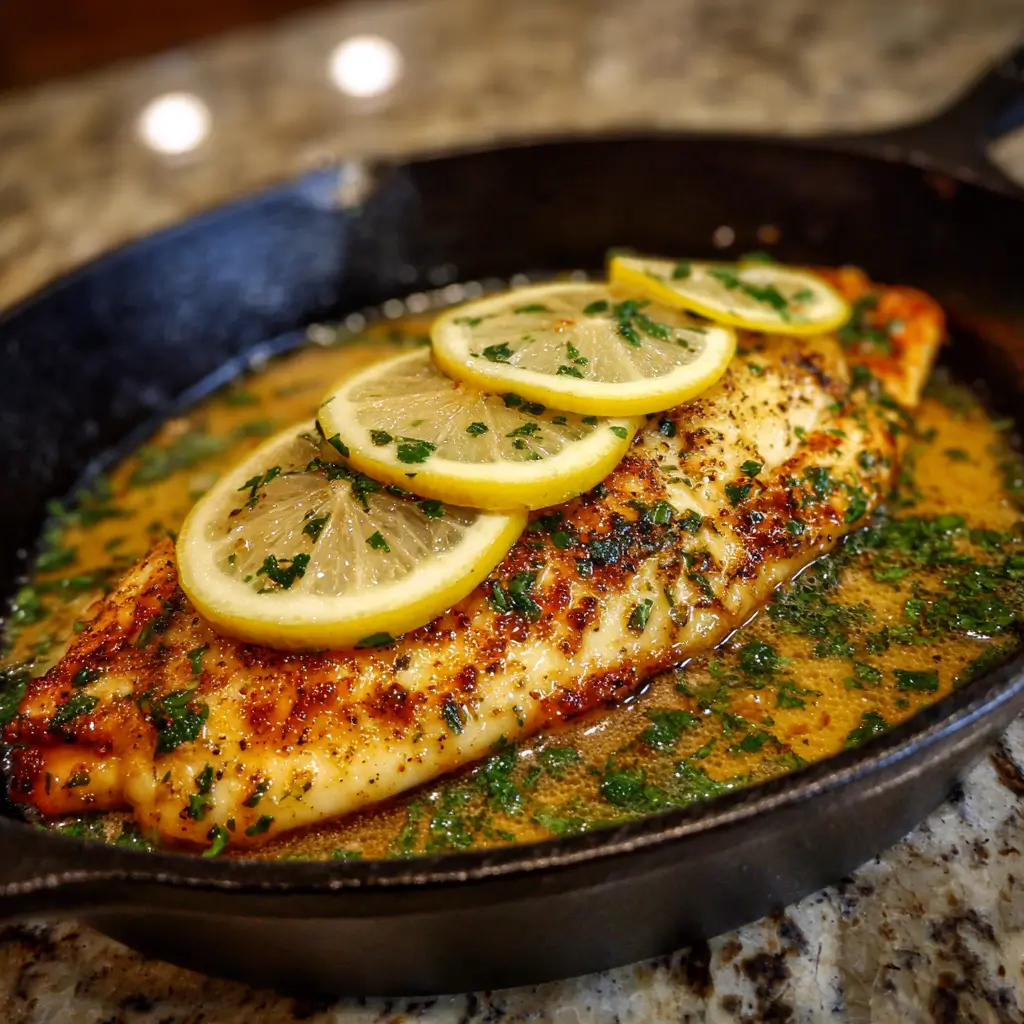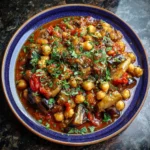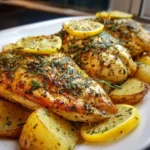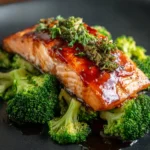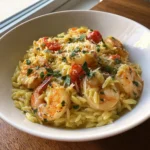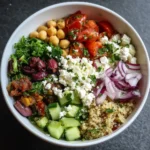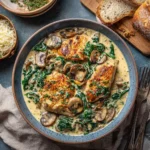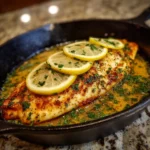Introduction
Lemon Butter Garlic Tilapia is a culinary masterpiece that brings together the delicate, flaky texture of tilapia with the vibrant, zesty tang of fresh lemon, the rich creaminess of butter, and the bold, aromatic flavor of garlic. This dish strikes the perfect balance between simplicity and sophistication, making it ideal for weeknight dinners as well as elegant weekend meals. With its bright citrus notes and savory depth, this recipe elevates humble tilapia into a gourmet experience. Whether you’re cooking for one or hosting a small dinner party, Lemon Butter Garlic Tilapia delivers restaurant-quality results with minimal effort. It’s a go-to option for health-conscious individuals, seafood lovers, and anyone seeking a quick, flavorful meal that doesn’t compromise on taste.
The History
The origins of Lemon Butter Garlic Tilapia are rooted in Mediterranean and coastal European cuisines, where simple preparations of fresh fish with olive oil, lemon, and herbs have been cherished for generations. While tilapia itself has ancient roots—originating in the Nile River in Africa—it wasn’t until modern aquaculture made it widely available globally that it became a staple in American and European kitchens. The use of butter and garlic in seafood dishes can be traced back to French cuisine, particularly dishes like sole meunière and moules à la crème. Over time, home cooks began combining these classic elements—butter, garlic, lemon, and white fish—into accessible recipes that highlight natural flavors without overpowering the fish. Today, Lemon Butter Garlic Tilapia is a popular choice in both home and commercial kitchens due to its versatility, short cooking time, and universal appeal. It represents a fusion of old-world techniques and modern dietary preferences, blending heart-healthy ingredients with bold, satisfying tastes.
Ingredients Breakdown
The magic of Lemon Butter Garlic Tilapia lies in its carefully selected ingredients, each contributing to the overall harmony of flavor, texture, and aroma:
- Tilapia Fillets: Mild in flavor and tender in texture, tilapia serves as the perfect canvas for bold seasonings. It’s low in fat, high in protein, and readily available year-round.
- Unsalted Butter: Provides richness and helps create a silky sauce. Using unsalted butter allows control over the sodium content and enhances the natural flavors.
- Fresh Garlic: Minced garlic adds pungent depth and aromatic complexity. When sautéed gently, it becomes sweet and nutty, infusing the entire dish with warmth.
- Fresh Lemon Juice: Brightens the dish with acidity, cutting through the richness of the butter and enhancing the natural sweetness of the fish.
- Lemon Zest: Adds an intense burst of citrus fragrance without extra moisture, intensifying the lemon presence in every bite.
- Olive Oil: Used for searing, olive oil provides a healthy fat base with a mild fruitiness that complements the other ingredients.
- White Wine (optional): A splash of dry white wine deglazes the pan and adds subtle acidity and complexity to the sauce.
- Fresh Parsley: Chopped parsley adds color, freshness, and a mild herbal note that balances the richness of the butter.
- Salt and Black Pepper: Essential seasonings that enhance all the other flavors, bringing balance and definition.
- Paprika (optional): A pinch adds a hint of warmth and color without overwhelming heat.
Together, these ingredients form a symphony of flavors that celebrate the natural quality of the fish while transforming it into something truly special.
Step-by-Step Recipe
- Prepare the Ingredients: Pat the tilapia fillets dry with paper towels to ensure a good sear. Season both sides lightly with salt, black pepper, and a pinch of paprika if using. Mince 3–4 cloves of garlic, zest one lemon, and juice half to three-quarters of a lemon. Chop a handful of fresh parsley.
- Heat the Pan: Place a large non-stick or stainless steel skillet over medium-high heat. Add 1 tablespoon of olive oil and allow it to heat until shimmering but not smoking.
- Sear the Fish: Carefully place the tilapia fillets in the hot pan, presentation side down if applicable. Cook undisturbed for 3–4 minutes, or until golden brown and the fish easily releases from the pan when gently lifted with a spatula.
- Flip and Finish Cooking: Gently flip the fillets and cook for another 2–3 minutes on the second side. The fish is done when it flakes easily with a fork and reaches an internal temperature of 145°F (63°C). Transfer to a plate and cover loosely with foil to rest.
- Make the Sauce: Reduce the heat to medium-low. In the same skillet, add 2 tablespoons of unsalted butter. Once melted, add the minced garlic and sauté for about 30–60 seconds, stirring constantly to avoid burning.
- Build Flavor: If using white wine, pour in ¼ cup and let it simmer for 1–2 minutes until slightly reduced. This step concentrates flavor and removes raw alcohol taste.
- Add Citrus: Stir in the fresh lemon juice and lemon zest. Allow the mixture to simmer gently for another minute, letting the flavors meld.
- Enrich the Sauce: Swirl in another 1–2 tablespoons of cold butter to give the sauce a glossy, restaurant-style finish. This technique, known as monter au beurre, adds luxurious texture.
- Finish with Herbs: Remove the skillet from heat and stir in the chopped parsley.
- Serve: Spoon the warm lemon butter garlic sauce generously over the cooked tilapia fillets. Serve immediately with your choice of sides such as steamed vegetables, rice, quinoa, or crusty bread for soaking up the sauce.
Tips
- Dry the Fish Well: Moisture is the enemy of a good sear. Always pat tilapia fillets dry before seasoning and cooking to achieve a golden crust.
- Don’t Overcook: Tilapia cooks quickly and can become dry if left too long. Watch closely during the final minutes and remove from heat just as it turns opaque.
- Use Fresh Garlic: Pre-minced or jarred garlic lacks the brightness and depth of freshly minced cloves. For best results, mince by hand or use a press.
- Control the Heat: Keep the heat at medium or medium-low when cooking garlic to prevent bitterness from burning.
- Baste for Extra Flavor: As the fish cooks, spoon some of the hot butter and oil over the top to baste it, infusing more flavor and keeping it moist.
- Rest Before Serving: Letting the fish rest for 2–3 minutes after cooking ensures even moisture distribution and prevents juices from escaping when plated.
- Adjust Acidity: Taste the sauce before serving. If it’s too tart, add a tiny pinch of sugar or more butter to balance the lemon.
- Serve Immediately: This dish is best enjoyed fresh. The sauce may separate if held too long, and the fish can cool quickly.
- Skillet Choice Matters: A heavy-bottomed skillet ensures even heating and better searing. Non-stick is great for delicate fish; stainless steel gives superior browning.
- Double the Sauce: If serving with pasta or rice, consider doubling the sauce ingredients to ensure plenty for drizzling.
Variations and Customizations
Lemon Butter Garlic Tilapia is highly adaptable to different tastes and dietary needs. Here are some creative ways to customize the dish:
- Add Cream: Stir in 2–3 tablespoons of heavy cream or half-and-half to create a richer, velvety sauce reminiscent of a creamy lemon Alfredo.
- Spice It Up: Add red pepper flakes or a dash of cayenne for a spicy kick that contrasts beautifully with the citrus and butter.
- Herb Variations: Substitute parsley with fresh dill, thyme, or basil for a unique aromatic profile—dill pairs especially well with lemon and fish.
- Wine Swap: Use chicken broth instead of white wine for a non-alcoholic version that still adds depth.
- Cajun Style: Rub the tilapia with Cajun seasoning before searing for a bold, smoky twist on the original recipe.
- Top with Cheese: Sprinkle grated Parmesan or feta over the fish during the last minute of cooking for a savory, salty addition.
- Baked Version: Arrange seasoned fillets in a baking dish, pour the lemon butter garlic mixture over them, and bake at 375°F (190°C) for 12–15 minutes for a hands-off approach.
- Grilled Option: Grill the tilapia on a well-oiled griddle or in a grill basket, then top with the warm sauce after cooking for a smoky outdoor flavor.
- Asian Fusion: Replace butter with coconut oil, add ginger and soy sauce, and use lime instead of lemon for a tropical twist.
- Stuffed Fillets: Butterfly the tilapia and stuff with spinach, sun-dried tomatoes, and goat cheese before searing and saucing.
- Gluten-Free and Keto Friendly: This recipe is naturally gluten-free and fits well within a ketogenic diet when served with low-carb sides like roasted broccoli or cauliflower mash.
Health Considerations and Nutritional Value
Lemon Butter Garlic Tilapia is not only delicious but also offers several nutritional benefits when prepared mindfully:
- High-Quality Protein: Tilapia provides about 21–26 grams of lean protein per 3-ounce fillet, supporting muscle maintenance and satiety.
- Low in Calories: A typical serving (one fillet with sauce) contains approximately 250–320 calories, depending on butter and oil amounts.
- Heart-Healthy Fats: While butter is used, pairing it with olive oil introduces monounsaturated fats, which support cardiovascular health.
- Omega-3 Fatty Acids: Though lower than fatty fish like salmon, tilapia still contains some omega-3s, which are beneficial for brain and heart function.
- Vitamin C and Antioxidants: Fresh lemon juice contributes vitamin C, aiding immune function and enhancing iron absorption from plant-based foods.
- Low Mercury Content: Tilapia is considered a low-mercury fish, making it a safe choice for children, pregnant women, and frequent seafood consumers.
- Digestive Benefits: Garlic contains allicin, a compound with antimicrobial and anti-inflammatory properties that may support gut health.
- Customizable for Diets: Easily adapted for low-sodium diets (use less salt), dairy-free (substitute butter with ghee or vegan butter), or low-fat versions (use less butter and more broth).
- Balanced Meal Potential: When served with whole grains and vegetables, this dish becomes a well-rounded meal rich in fiber, vitamins, and essential nutrients.
However, moderation is key—especially with butter and added fats. To reduce saturated fat, consider using half butter and half olive oil or incorporating a light garlic-lemon vinaigrette alternative.
Ingredients
- 4 tilapia fillets (about 6 oz each), skinless
- Salt and freshly ground black pepper, to taste
- 1 teaspoon paprika (optional)
- 1 tablespoon olive oil
- 3–4 cloves garlic, minced
- 4 tablespoons unsalted butter, divided
- ½ cup dry white wine (such as Sauvignon Blanc or Pinot Grigio) OR chicken broth
- Juice of ½ to ¾ lemon (about 2–3 tablespoons)
- Zest of 1 lemon
- 2 tablespoons fresh parsley, finely chopped
Directions
- Pat the tilapia fillets dry with paper towels and season both sides with salt, pepper, and paprika if using. Set aside.
- Heat olive oil in a large skillet over medium-high heat until shimmering.
- Add the tilapia fillets and cook for 3–4 minutes on the first side until golden brown. Flip carefully and cook for another 2–3 minutes until the fish is opaque and flakes easily with a fork. Transfer to a serving plate and cover loosely with foil.
- Reduce heat to medium-low. Add 2 tablespoons of butter to the same skillet. Once melted, add the minced garlic and sauté for 30–60 seconds until fragrant.
- Pour in the white wine (or broth) and simmer for 1–2 minutes to reduce slightly.
- Stir in the lemon juice and lemon zest. Simmer for another minute.
- Remove from heat and swirl in the remaining 2 tablespoons of cold butter, one piece at a time, until the sauce is smooth and glossy.
- Stir in the chopped parsley.
- Immediately spoon the sauce over the cooked tilapia fillets.
- Serve hot with your favorite side dishes.
FAQ
Can I use frozen tilapia?
Yes, but thaw it completely in the refrigerator overnight for best texture. Never cook frozen tilapia directly—it will release too much water and steam instead of searing.
What can I substitute for white wine?
Use dry vermouth, additional lemon juice mixed with broth, or simply omit it and use extra broth for deglazing.
Is tilapia healthy?
Yes. Tilapia is low in mercury, high in protein, and low in saturated fat. While it has fewer omega-3s than oily fish, it remains a nutritious and sustainable seafood option.
Can I make this dairy-free?
Absolutely. Use a high-quality plant-based butter substitute or coconut oil instead of butter. The flavor will vary slightly but still be delicious.
How do I store leftovers?
Store in an airtight container in the refrigerator for up to 2 days. Reheat gently in a skillet over low heat to prevent overcooking.
Why did my fish stick to the pan?
This usually happens if the pan wasn’t hot enough or the fish wasn’t dry. Ensure the skillet is properly preheated and always pat the fish dry before cooking.
Can I bake this instead of pan-searing?
Yes! Place seasoned fillets in a greased baking dish, pour the sauce over them, and bake at 375°F (190°C) for 12–15 minutes until cooked through.
What sides go well with this dish?
Excellent pairings include roasted asparagus, garlic mashed potatoes, wild rice, quinoa, steamed broccoli, orzo, or a crisp green salad.
Can I double the recipe?
Yes, but cook the fish in batches to avoid overcrowding the pan, which leads to steaming instead of searing.
Is this kid-friendly?
Definitely! The mild flavor of tilapia and the creamy, tangy sauce make it appealing to children. You can reduce garlic or lemon if needed.
Summary
Lemon Butter Garlic Tilapia is a fast, flavorful, and nutritious dish that combines tender fish with a bright, aromatic sauce made from butter, garlic, and fresh lemon. Perfect for busy weeknights or special dinners, it’s healthy, customizable, and loved by seafood enthusiasts of all ages.
